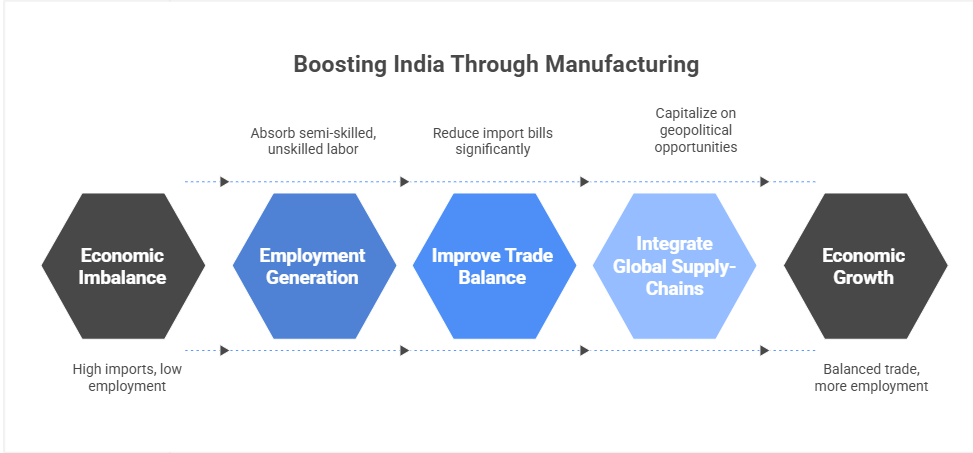-
17 Jul 2025
GS Paper 3
Economy
Day 28: "India aspires to transition from being a consumer-driven market to a manufacturing-led economy.” Critically evaluate the role of Make in India and PLI schemes in realising this transformation. (150 words)
Approach:
- Begin by stating the need for a manufacturing-led economy.
- Evaluate the impact of Make in India and PLI schemes with achievements and challenges.
- Conclude with a suitable way forward.
Introduction:
India's economic growth trajectory has been largely driven by domestic consumption and services. However, this model has shown limitations in job creation and trade balance. To pivot towards a manufacturing-led economy, the government launched flagship initiatives such as ‘Make in India’ (2014) and ‘Production Linked Incentive (PLI)’ schemes (2020).
Body :
Role of ‘Make in India’
- Launched in 2014, Make in India aimed to raise the share of manufacturing in GDP to 25% by 2022 and create 100 million jobs.
- As part of the 2025 National Manufacturing Mission announced in the Union Budget, Make in India 2.0 aims to ramp up domestic production in electronics, renewables, and food processing, while launching dedicated plans for sectors like toys and leather.
- Achievements:
- FDI Inflows reached $83.5 billion in 2021–22, reflecting improved investor confidence.
- Ease of Doing Business (EoDB) rank improved from 142 (2014) to 63 (2019).
- Boosted infrastructure via Industrial Corridors and reforms in sectors like defence, railways, and mining.
- Limitations:
- Manufacturing’s share in GDP remains stagnant at ~17% (2023).
- Job creation did not meet targets—CMIE data suggests formal employment grew slowly.
- Many reforms remained policy level without robust ground-level implementation, especially at the state level.
Role of Production Linked Incentive (PLI) Schemes
- Introduced post-pandemic in 2020, PLI schemes cover 14 key sectors such as electronics, pharma, solar modules, and textiles. They offer financial incentives based on incremental production and sales.
- Impact:
- Expected to generate ₹3–4 lakh crore investment and 60 lakh jobs (NITI Aayog).
- Mobile phone exports crossed ₹90,000 crore in FY 2022–23, with Apple and Samsung ramping up domestic production.
- Encouraged backward linkages in electronics and EVs.
- Challenges:
- Predominant participation by large firms—limited MSME inclusion.
- Sectors like semiconductors face delays and high import dependence.
- Risk of becoming subsidy-dependent rather than innovation-led.
Conclusion:
Make in India created a vision, while PLI offers a targeted execution strategy. However, India's path to a manufacturing-led economy also requires skilling, logistics efficiency, R&D, and labour reforms. As Raghuram Rajan noted, “India must focus not just on what to produce, but how to produce competitively.” The transformation must be structural, inclusive, and innovation-driven for long-term success.






